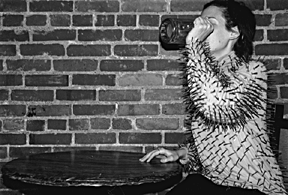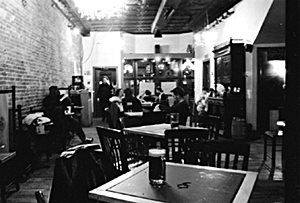


by Laren Rusin
Perhaps it's the lingering smell of onions that follows me into English class. Or the fact that I can be seen wearing the same nasty clothes around campus five days a week. Or the ever-present styrofoam cup of coffee I have in my hand and the coffeegrinds under my nails.
That's the glamour of the Feve. I've worked there for two years now, at least 20 hours a week through the duration, while remaining a full-time student. When I first applied for a job, I remember many of my friends begging me, "Don't become a Feve bitch, please." And what exactly does that mean? Let me see. I have brown hair, brown eyes, average height, weight. I get mistaken for everyone else on the planet.
I understand that there's a mystique that someone attains when they step on the other side of the counter. Maybe the lighting is flattering, or the waft of coffee perks up flat hair. There's the rumour that the Feve only hires physically attractive people. I won't comment on that - judge for yourself.

It's a high profile job -if you're out "on counter," as opposed to being in the kitchen, people look at you. A lot. And they're not subtle about it. During the summer, when it's about 200 degrees in the kitchen, it's tempting to wear as little clothing as possible when standing over a grill for eight hours. But after one too many comments that rubbed me wrong, I now stick with a nice big t-shirt. It pisses me off that customers can make employees feel so self-conscious and on display, but it's a fact of life. Everyone jokes about dressing for tips, but we all know what works and what doesn't -certainly what sells - and if you're not sure, it doesn't take a genius to figure out. Seen a Calvin Klein ad recently?
There are the truly condescending people who assume that, because you work at a job that pays barely over minimum wage, you have the IQ of a duck. A fellow employee was looking for a price off the coffee menu, squinting because she had forgotten her glasses, and the customer said, loudly, "That's espresso con panne, hon - e-s-p-r-e..."
Or that you're deaf and can only hear if yelled at -"hey hey hey you," one person once said to me rather loudly, on a quieter afternoon. I turned around. "Um," he said, "there are supposed to be onions on this." He thrust the plate out at me. Nice manners. Thank you, enjoy your meal, and please, please, come again. There are so many dichotomies acted out in the Feve dining room it's rather heartening to know that sweeping generalizations and gross stereotypes come from something concrete.
This certainly isn't meant to be a diatribe on the concerns of people in food service. Nor is it meant to plug a certain coffee house in question. There are at least two sides to every story, and one is always more apparent than the other, depending on who you are.
So. The Feve is a nice place to hang out. I'd agree. It's pretty hip, I suppose. There are going to be people that hate the Feve, just as there are those who hate McDonald's or capitalism or their parents. There are lovelies and uglies who work there, and there are kickass workers and those that could use a kick in the ass. But someone's going to go into the Feve by choice, and be happy about it, it may just depend on whether that person comes in while The Smiths are playing, or if it's Aphex Twin. You never know. But it's not a customer's place to go and change the music, either. It seems that only in Oberlin students feel they have the right to make changes in atmosphere and décor of their own accord. Is it the self-empowerment that Oberlin tries to encourange in its bright student body, or the raging and ridiculous political consciousness that seems to pass as license to ignore other peoples' feelings and personal taste?
And isn't a little suspense exciting? What are the muffins of the day going to be? Will or will there not be a soup of the day? Is that dashing young man working the grill? Hell, if a dark place to read and a little mystery is what you're looking for in Oberlin, it's as good a place as any. Maybe the Feve is just an outlet for the romantic soul in any of us. But really, now, who am I to say? I just take your order.
Slurp it down: Oberlin kids run in droves to the Feve, where the coffee is as bad as the service is badass. (photo by Pauline Shapiro)
by Brian Gresko
What is popular culture, and what, exactly, does it mean to "zoom in" on it? These were never important questions to me. The subjects of this feature never challenged my ideas about popular culture, nor made me question what popular culture consists of. I was always able to identify with certain articles, and not identify with others, every week reaffirming my sense of pop culture engagement and identity.
That was until the Feve was suggested as a possible feature topic. Now I had reason to pause: of course the Feve is part of Oberlin's popular culture. It is firmly rooted within the vernacular of student speech and mythology; everyone knows what the Feve is, and has an opinion of it. But what does it mean to consider it as a part of pop culture?

This article doesn't focus on the Feve as a cultural institution, but rather examines the importance of discussing pop culture at all. The Feve just presents a particularly localized and recognizable example of this situation.
At its heart, the retail industry of culture is about economics. No matter what one's opinions may be about its atmosphere or aesthetics, the Feve basically functions as a restaurant. This separates the Feve from other consumable items of culture because it deals with food, something everyone needs. If you were really hungry, and had no other choice, of course you would go to the Feve, though even if really bored you might not watch a show like The Simpsons.
As a social space, the Feve cultivates a certain image and attitude as a cool, hip place to hang out. In effect, there are two Feves: the Feve, a place which serves coffee, and "The Feve," a place which designates a person as hip, alternative, postmodern. But does the Feve actually say much about a person, or does talking about it only exaggerate its significance?
It's obvious that The Feve has the look, feel, and atmosphere of an urban coffee house. This lends it an air of hipness. On the right day, within the Feve's depths, I like to think that Ohio's flat cornfields and gray skies are somewhere far away. And I do feel a certain comfortable level of satisfaction, a detached feeling of calm, sitting on straight-backed, hard-bottomed chairs, listening to the employees' loud music, and sipping on my mug of coffee.
Probably everyone knows people who feel intimidated by the Feve's social scene. Though I've never encountered any strong reaction when I tell people I get coffee at the Feve almost every day, I'm sure it's possible to make assumptions about me based on this fact. Maybe I'm just not sensitive enough to others' reactions to pick up on their opinions.
Really though, all I can say about the Feve is that I like dark spaces with wooden floors where coffee and beer are easily accessible, hence I enjoy spending my time there. I can speculate on the aura surrounding it in campus culture, but in the end this would only reveal my own prejudices about students on campus, rather than provide any particularly illuminating observations.
Let me provide an example. I don't like Wilder Bowl, nor feel comfortable walking through and hanging out there. All that fresh air and sunshine with no comfortable place to sit makes me nervous. I like chairs and tables rather than grass. I can easily write an essay projecting my dislike of the space onto the people who sit there. I could say that my feelings of intimidation, of feeling on display, stem from the people sitting on the grass who are watching me.
But really this would be an exaggeration. Any social space, from A Level to Quarter Beer, creates its own dynamic. Because I don't particularly want to sit in Wilder Bowl, and therefore don't, I feel like an outsider. The people who do sit there don't recognize me, so therefore they stare and make me feel uncomfortable. Its a two-way street-it's territorial in nature. The same is true of the Feve.
The difference between talking about these real campus social spaces and an object like a TV show or book is that these spaces contain real people with whom I interact daily. An object like a TV show is an abstract social space; for those who watch it, the show provides a common subject for people to discuss but not a place they actually inhabit. Similarly, the Feve creates its own micro-society of lingo and characters. But whereas the audience for a TV show is generally theoretical in nature, The Feve is a concrete, real space on campus.
To make widespread generalizations about the people who frequent it or work there would be unfair: it hurts the feelings of a specific, identifiable set of people. Not only that, but what of the fact that so many people patronize the Feve, it's impossible to make any such generalizations anyway. Though the point of commenting on pop culture is not to create an objective article, when taking a subject as localized as the Feve, its easy to see how stereotypes could be made. The line between a theorizing essay and personal diatribe could easily be crossed. It's one thing to identify the ways in which the Feve is hip or the Teletubby Tinky Winky effeminate, it's another to insult the hipsters and condemn homosexuality. This kind of essay says more about the author of the sentiment than it does about the subject being commented on.
The importance of zooming in on pop culture each week is to examine these personal attitudes, and also see how they connect into larger ways of thinking about the world as a whole. If the way in which one categorizes the Feve fits into the way in which one categorizes people in Oberlin, then social dynamics and prejudices are revealed. Furthermore, any complete discussion of the Feve taps into more abstract, overarching ideas about restaurants and bars in general, taste in food, and architectural aesthetics.
Nice chairs: The Feve dining room is one of the more picturesque eating mileius in Oberlin. It is without a doubt a part of Oberlin pop-culture as a locus of hipness between the cornfields. (photo by Pauline Shapiro)
Copyright © 1999, The Oberlin Review.
Volume 127, Number 18, April 2, 1999
Contact us with your comments and suggestions.